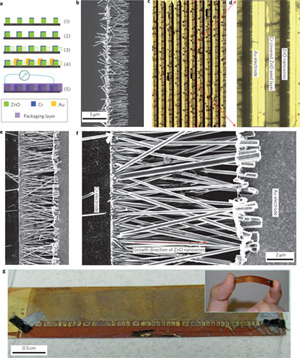| Present piezoelectric materials and devices show promise for niche power-harvesting applications, but their improved performance is necessary to achieve size, weight, and cost objectives in order to compete with existing energy sources. Xu et. al. report a facile approach to both vertical and laterally-oriented piezoelectric nanowire arrays for integrated piezoelectric devices. |
Reviewed by Jeff Morse, PhD., National Nanomanufacturing Network
The availability of vibrational and mechanical energy from numerous sources within everyday environments presents a compelling argument for energy harvesting at both large and small scales. Human motion, motors, wind, and ocean waves are prime examples of available ambient energy sources. Present piezoelectric materials and devices show promise for niche applications, but their improved performance is necessary to achieve size, weight, and cost objectives in order to compete with existing energy sources. While certain materials structures, such as nanowires of specific composites, exhibit exceptional performance, without an integrated device strategy, practical systems for power harvesting will not be realized.
Integration of piezoelectric devices with energy storage devices enables the notion of self-powered electronics and sensors for a range of applications. Scaling of energy scavenging devices to large area applications further offers a renewable energy supply that ultimately may provide continuous power to the grid, should long term cost objectives be met. The path to these scenarios is through scalable integration and nanomanufacturing strategies that will enhance the performance while reducing the cost of piezoelectric energy harvesting devices and materials.

In order to optimize the power generated from the ZnO nanowire array, both the physical and crystallographic orientation of the nanowires must be aligned. In this manner the voltage drop across each individual nanowire is in parallel and the array will then exhibit the full potential exhibited by an individual element. The authors further investigated an approach to integrate lateral ZnO nanowire arrays on a flexible substrate. Using Kapton as the substrate, 300 nm thick ZnO seed layer stripes were patterned then coated on the top and one side with a thin film of Cr to prevent the growth of ZnO nanowires on those surfaces. Aligned nanowires, nominally with similar crystallographic orientation were then grown using a similar chemical decomposition process. Gold electrodes were then patterned at the other end of the as-grown nanowires, resulting in several lateral nanowire arrays connected in series. Testing of the laterally integrated nanowire arrays exhibited large voltages (~1.2 V) but the current was limited to ~29 nA for the entire array. The authors attributed the limited current density to a low fraction of crystallographically aligned nanowires, along with poor electrical contacts as many nanowires apparently broke contact to the Au as compressive strain or bending was applied to the substrate.
Nonetheless, a facile approach to both vertical and laterally-oriented piezoelectric nanowire arrays has been reported. Further improvements in crystal alignment and control of orientation within the nanowires along with improved electrode designs will result in substantially improved device performance thereby laying the framework for large scale integrated energy harvesting devices.
Image reproduced by permission from Macmillan Publishers Ltd: Nature Nanotechnology Xu S, et al. Self-powered Nanowire Devices. Nature Nanotechnology 5:366 - 373 (2010). DOI: 10.1038/nnano.2010.46. Copyright 2010.
This work is licensed under a Creative Commons Attribution-NonCommercial 3.0 Unported.
